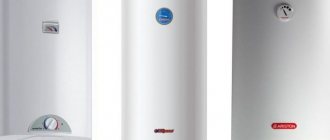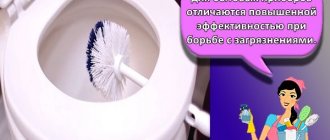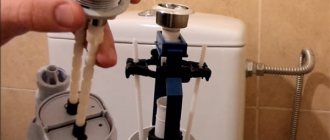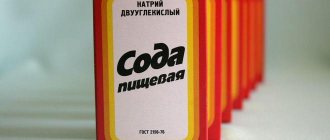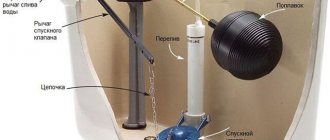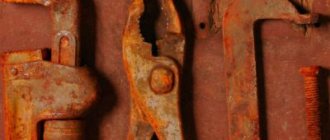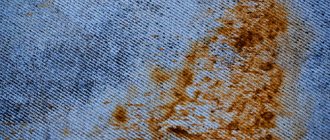Causes of clogged drain tank
It would seem that there is nowhere for dirt to come from a closed container. However, a dark coating sooner or later appears on the walls of the tank. This is due to the following reasons:
- Tap water is not perfectly clean. It almost always contains impurities of mineral salts and rust, which settle on the walls of the tank. The tank gets especially dirty on days when water pipes are being repaired in the house. After such repairs, very rusty water usually flows from the tap for some time. Naturally, the same water enters the tank, and dirt settles on the walls. Over time, the dirt petrifies, turning into a limescale build-up that is highly hard and difficult to remove.
- The lid on ceramic products fits quite tightly. However, sometimes it happens that it is not closed well, and then dust gets inside, which settles at the bottom of the tank and becomes a breeding ground for mold fungi.
- Lack of hygiene. In many homes, this container is not cleaned for years: they simply forget about it. If the product is not cleaned, sooner or later dirt will appear in it.
Plaque on the walls of the barrel or dirt on the bottom of the product shortens its service life. Water in such a tank begins to leak from under the valve. In addition, dirty water clogs the toilet itself, it quickly loses its whiteness and shine. In order for the hygiene room to be cozy and clean, it is necessary to systematically restore order.
Prevention measures
If you follow the recommendations of plumbers, you can avoid the accumulation of plaque on the walls, wash the equipment less often and with less effort. Firstly, you need to monitor the pipelines: rusty metal communications used in the house cause the formation of a red coating. Plastic pipes are considered less problematic.
Directly into the tank you can place special products in the form of tablets designed to protect against plaque. Such household chemicals may also have a gel consistency. Every few weeks, it is advisable to remove the tank cap to ensure its proper condition and promptly eliminate soft deposits.
How to properly clean the drain tank?
The first thing to do to clean the tank is to open it. Modern tanks are not so easy to open. The fact is that when you lift the lid, the drain button will be automatically pressed. To avoid problems, before cleaning the toilet tank from rust inside, you need to turn off the running water. Then you need to press the drain button to empty the container. As a rule, it is on this button that the lid itself is held on. To remove it, you just need to twist the cover together with the part that secures it counterclockwise. She'll take off.
To remove the lid from the toilet cistern, first remove the flush button
In plastic tanks, the part that holds the lid is usually attached to the side with screws or bolts. You need to unscrew it and remove the cover to the side.
Then you can start cleaning the drain tank. This can be done using store-bought household chemicals or at home.
How to remove rust from a toilet tank
After this, it is necessary to dismantle all the elements located inside. It is also recommended to rinse removable elements under running water and treat them with cleaning agents.
Cleaning using specialized products
When choosing products for cleaning a toilet tank from a thick coating of rust, it is recommended to give preference to specialized chemicals:
The difference between these products lies in the additional components included in the cleaning products. Each product, depending on the volume of packaging, costs about 100–150 rubles. The basis of the above products are organic acids, which corrode the resulting plaque. The main disadvantage of such products is considered to be a pungent odor that does not disappear within several hours.
To clean toilet tanks at home with this professional chemical, you need to apply the selected product to the contaminated areas, wait 5-10 minutes (depending on the degree of contamination) and rinse with water.
Simple cleaning method
To remove plaque you will need:
- Pour citric acid into the tank.
- Wait for two minutes.
- Wash the inner walls.
Watch the video - how to simply and easily clean the toilet tank.
In this case, there is no need to dismantle the internal parts and drain the water.
Citric acid helps deal with fresh traces of rust. For other cases, more aggressive means are used.
Removing old plaque
This liquid should be applied to the inner walls and left for 15 minutes. Then you need to turn on the water and wash off the remaining acid.
Gloves must be worn when working with this liquid. It is recommended to wipe down the walls with a brush after treating the surface.
If a little deposits have accumulated on the walls, then acetic acid can be added directly to the water without emptying the toilet tank.
Universal method
In this case you need:
- Mix both components in equal proportions without adding water.
- Apply to the walls and bottom using a sponge or spray bottle.
- Wait for 1–2 hours.
This method is effective against minor stains. If after the first time the mixture does not clean the inner walls, you should use a professional product, since the latter will ultimately be cheaper.
At the end of the specified time, it is necessary to clean the inner walls with a hard sponge, and then wash off the remaining peroxide and ammonia.
Cleaning the drain tank with store-bought products
If the plumbing fixture has not been cleaned for a long time, the deposits on its walls and bottom will not be easy to remove. Therefore, to wash the tank in this case, it is recommended to use a store-bought product that is usually used to clean the toilet itself. Moreover, any housewife almost always has a “toilet duck” of any brand in her arsenal. The most common cleaning agents are:
- Sanox. This is a budget gel that can quite effectively remove limescale and rust from the walls of ceramic products. A bottle of Sanok gel costs only 330 rubles, and the result of use most often completely satisfies the housewives.
- Domestos. One of the most famous gels for cleaning toilets. It cannot be classified as cheap, but it has long won the trust of the most pedantic housewives, because it is really capable of a lot. True, it also has disadvantages: its composition is very aggressive and can harm sensitive people. If you still decide to take a risk, try to work with it as carefully as possible, put on a protective mask, open a window in the apartment so that the harmful fumes evaporate faster. A bottle of gel with a capacity of 500 ml costs about 600 rubles.
- Sanfor. This is a cheaper analogue of Domestos, which is impressive in its ability to dissolve limescale, urinary stone and rust. You can find several varieties of this product on sale: Sanfor anti-rust, universal, disinfection, etc. Each of them is designed to combat one or another contamination.
The product will help cope with contamination and disinfect surfaces.
- Sillit. This gel contains caustic acids, thanks to which it copes well with various contaminants. It will quickly clean the toilet tank of old plaque.
- Cinderella. This toilet gel removes unpleasant odors, plaque and rust. Quite an effective budget tool.
- Comet. A popular cleaning product that is highly effective. This product is praised by many experienced housewives.
- Cream Cif. It gently cleans the ceramic surface, while effectively removing dirt - limescale, rust, dust. The cream is applied to a sponge and the walls and bottom of the tank are polished with it. You can keep it on the surface for 10 to 30 minutes. Then rinse thoroughly with water.
Cinderella - a budget assistant in the fight for cleanliness
The popular Whitener with chlorine will effectively remove black deposits from ceramic surfaces. You just need to pour it into the tank, fill it with water and leave it for 4-5 hours, then drain it. Any of the listed means for cleaning the walls of the tank is used according to the same rules:
- First, using a hard sponge, the product is applied to the walls of the plumbing fixture. It is necessary to work with gloves. If a caustic chemical is used for cleaning, it is also a good idea to wear a special protective mask.
- After application, the product must be left on the surface for some time. If the contamination is severe, you can extend the time of contact with the cleansing gel to 12 hours, but this rule only applies to those substances that are gentle. For example, it is better to put citric acid in the tank overnight, but it is undesirable to leave chlorine-containing substances for the same period of time.
- After a certain time, the walls and bottom of the tank should be thoroughly rubbed with a sponge to remove any remaining dirt and deposits.
- After the described manipulations, you need to fill the tank with water and drain it several times.
After cleaning the plumbing, the toilet should be ventilated. This type of cleaning can be done once every 3-4 months.
A brush or stiff sponge can help remove heavy dirt.
Store-bought products are effective and easy to use. In addition to those listed above, you can use many other similar cleaners: modern manufacturers of household chemicals offer a wide selection of different substances. But if you don’t have such a gel at home and you can’t buy it at the moment, you can use home remedies. How to clean the inside of a toilet tank without a special product? Any housewife can find the answer to this question in her kitchen.
Pollution prevention
The following recommendations help to avoid the appearance of rust and lime deposits on plumbing fixtures:
- Clean the inside walls and bottom of the tank regularly.
- Monitor the condition of the water and promptly replace worn pipes.
- Use special tablets that prevent plaque formation.
When cleaning the inner walls of the tank and toilet, it is not recommended to use several products at the same time. The consequences of such actions cannot be predicted.
Homemade Cleaning Remedies
If the tank is not very dirty, a non-aggressive product will cope with the contamination. The following substances can be used as weapons:
- Table vinegar. This substance is not particularly caustic, but it is quite capable of coping with a small coating. You need to work with it the same way as with other cleaning agents: saturate a sponge with it and wipe the surfaces. Leave for half an hour, then rinse.
- Soda. It helps to wash away many types of contaminants and also removes traces of rust if it has not yet become deeply ingrained. The powder is applied to a sponge, which is then used to clean the inner walls of the tank. Soda will not remove heavy dirt, so leaving it on the surface for a long time does not make sense. The product is usually washed off immediately after cleaning the plumbing fixture.
- Oxalic acid. Pour the acid powder onto a cloth, rub it on the contaminated surface, leave for an hour, then rinse with water.
- Toothpaste. This popular and affordable product for cleaning the inside of the tank is found in every home. It is used in the same way as other household cleaners: applied to a sponge and cleaned the surface. After the manipulations, the paste is immediately washed off.
Cleaning should be done regularly, this will help preserve the tank mechanism
- Lemon acid. This simple remedy will work well even with petrified deposits on the walls of the tank. Using the product is easy. It is enough to take 2-3 bags of acid (100 g each), pour them into a tank filled with water, stir and leave for 4-5 hours, then drain the water. If possible, it is advisable to first fill the tank with hot water and pour acid into it. The effect of application is wonderful. If, after such an acidic procedure, traces of contamination remain on the walls, they can be washed off with a sponge and soda or cleaning powder for kitchen surfaces.
- Washing powder. It perfectly removes contaminants of various origins, if they have not yet become firmly ingrained. The product is applied to an ordinary sponge, used to clean the walls of the tank, and washed off immediately, otherwise the powder will dry out and you will have to scrub it off. After this method, the product will not only shine with cleanliness, but will also acquire a pleasant aroma.
Beautiful and Successful knows how to clean a clogged toilet >>
- Battery electrolyte. This substance contains aggressive acids, so the electrolyte easily and quickly removes black deposits and rust from surfaces. At home, this product for cleaning the inside of the toilet tank will help bring even very neglected plumbing fixtures into perfect condition. Cleaning is easy. It is necessary to pour the liquid into the tank and leave for an hour. Some sources recommend leaving the electrolyte in the reservoir for up to 4 hours, but this is not worth the risk. Sulfuric and hydrochloric acids, which are part of the substance, can corrode the plastic parts of the cistern, especially if they have been in use for more than a decade. The site sympaty.net recommends using this substance only in extreme cases, when the tank is actually very dirty. If there is only a small coating on the walls inside, you can get by with safer means. Those who decide to try the power of electrolyte on their own toilet are advised to strictly follow all safety measures: the substance instantly corrodes the skin and burns mucous membranes.
- Sandpaper. If you do not want to resort to chemical compounds, you can use abrasives, in particular sandpaper. True, it is inconvenient to use on a wet surface.
Baking soda is a simple home remedy for cleaning your toilet, including
Some housewives say that you can clean your plumbing with Coca-Cola, but this drink is unlikely to give the desired effect, and to fill the tank you will need to purchase more than one bottle, so it would be much more reliable to purchase a special cleaning agent.
It makes sense to try the power of cola as a cleaner only if for some reason at home there are such reserves of this product that it is safer to pour it down the toilet than to drink it.
When cleaning the inside of the toilet tank, you should pay attention not only to the walls of the product, but also to the flush mechanism itself. Ideally, it would be to disassemble it into parts and thoroughly clean each element, but then it will have to be put back together. If you are not sure that you can do this, it is better to wipe all surfaces with a damp cloth.
Second phase
To clean the toilet cistern, you need to select cleaning products. If a layer of plaque has formed in the tank, abrasive cleaners and a rag will help remove it. Apply the product to the walls of the tank and leave to act for a few minutes. Then wipe the walls with a rag. Repeat the procedure if necessary. In addition to abrasives, there are alkaline cleaners. They not only cope with plaque, but also disinfect the surface. They are also applied to the walls and left for a while. If you have time, you can leave it for several hours to improve the effect.
There are acidic agents. They deal with plaque even faster, but contain acid, which can negatively affect human health. Therefore, when using acidic cleaning products, you should follow safety precautions: wear gloves and do not lean over the tank so as not to inhale acid fumes. In addition to household chemicals, you can use folk remedies. One of the popular remedies that cope with plaque is citric acid. Baking soda and acetic acid also have a similar effect.
They should be applied to the walls of the tank and left for 2-3 hours. Then wash off. But some housewives have adopted cola as their weapon of choice in the fight against plaque. It should be poured into an empty tank and left overnight. After this procedure, even old dirt and plaque are removed. If the pollution is minor, then chlorine-containing substances, for example Whiteness, can cope with them. But they are not able to cope with a rather thick layer of plaque.
To improve the effect of any product, be it household chemicals or folk remedies, use brushes or metal sponges and brushes. But they can be used if the surface of the tank is not glossy. Otherwise, there will be scratches in which plaque will accumulate. Therefore, for smooth surfaces it is better to use soft cloths. After cleaning the toilet cistern, you should screw all the components into place. Then put the lid on and turn on the water. After the tank is full, pull it all off so that if there are any particles of product left, they are washed off.
How to prevent the appearance of severe pollution?
Experts recommend cleaning the drain tank at least once a quarter. If the container has not become very dirty during this time, you can simply rinse it with clean water and wipe the surfaces with a napkin.
To make cleaning the tank easier, experts recommend buying special cleaning tablets for it. They not only prevent sediment from forming inside the tank, but also clean the toilet itself, disinfect the device and at the same time work as an air purifier.
But even if you use such tablets, you still need to keep an eye on the cleanliness of the tank. To do this, it will be necessary to clean the inside of the toilet tank 2-3 times a year using improvised means.
Keeping the toilet clean is very important both for the health of the family and for maintaining comfort in the apartment. If everything is done in a timely manner, this procedure will not cause any special difficulties.
Website www.sympaty.net – Beautiful and Successful. Author: Elena Burenyuk. More information about the site's authors
How to open a drain tank
On some models, you just have to lift the lid and put it away so it doesn’t get in the way. Others have the top screwed to the reservoir. To separate them, you need to press the ring around the flush button.
In plastic vessels, the lid is often attached to the sides. In this case, the fasteners are unscrewed with a screwdriver.
If the tank is walled up in the wall, you will not be able to get to it.
Some complex toilet models have non-standard fastenings of the lid to the water tank. In this case, you will have to use the attached instructions.

